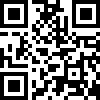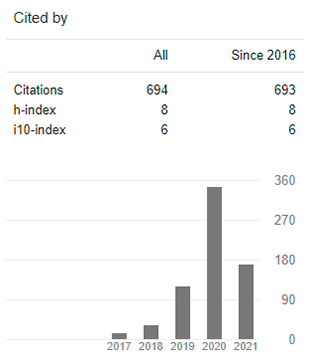Web applications, source of solutions and exclusion for education in times of COVID-19
DOI:
https://doi.org/10.29394/Scientific.issn.2542-2987.2021.6.22.21.397-417Keywords:
tics, applications, web, exclusionAbstract
The use of Information and Communication Technologies (ICTs) and the great set of web applications that make it up have been essential for the continuity of the educational process, paralyzed by the COVID-19 pandemic, generating that teachers, educational authorities and students are forced not to attend educational centers. Having as the main solution to this problem, continue the educational process, through the virtual modality, where ICTs have been the main solution, however, the use of these has caused several problems for students and teachers. That is why the present work was based on a bibliographic research, taking as a reference authors such as Martínez (2018); and Enríquez (2020); among others, since the objective of this research is to give a brief analysis of the contributions that ICT and the set of various web applications that make it up have provided, and at the same time demonstrate the exclusion that has been generated, due to their misuse or lack of access to them, at the Ecuadorian higher education level, having as a main conclusion that ICT should be implemented as universal access, so that no labeling or classifications are produced in the educational field.
Downloads
References
Agudo, S., Pascual, M., Fombona, J. (2012). Usos de las herramientas digitales entre las personas mayores. Comunicar, (39), 193-201, e-ISSN: 1134-3478. Recuperado de: https://doi.org/10.3916/C39-2012-03-10
Álvarez, G. (2012a,b). Las nuevas tecnologías en el contexto universitario: sobre el uso de blogs para desarrollar las habilidades de lectoescritura de los estudiantes. Revista de Universidad y Sociedad del Conocimiento (RUSC), 9(2), 3-17, e-ISSN: 1698-580X. Recuperado de: http://dx.doi.org/10.7238/rusc.v9i2.1160
Da Silva, M., & Ornellas, A. (2017). Potencialidades de un modelo colaborativo para la apropiación de las TIC en un contexto de vulnerabilidad social. Revista Psicopedagogía, 34(104), 216-227, e-ISSN: 0103-8486. Recuperado de: http://pepsic.bvsalud.org/scielo.php?script=sci_abstract&pid=S0103-84862017000200011
Enríquez, M. (2020a,b,c). Características de las herramientas multimedia para el desarrollo de Presentaciones Interactivas. Journal of Science and Research, 5, 873-891. Recuperado de: https://revistas.utb.edu.ec/index.php/sr/article/view/1044
Flores, M., Aguilar, A., Hernández, Y., Salazar, J., Pinillos, J., & Pérez, C. (2017). Sociedad del conocimiento, las TIC y su influencia en la educación. Revista Espacios, 38(35), 39-50, e-ISSN: 0798-1015. Recuperado de: https://www.revistaespacios.com/a17v38n35/a17v38n35p39.pdf
González, M. (2019a,b,c). Genially. Libros interactivos geniales. ISSN: 2695-4176. Madrid, España: Ministerio de Educación y Formación Profesional; Instituto Nacional de Tecnologías Educativas y de Formación del Profesorado (INTEF).
Marco, C., & Chóliz, M. (2013). Tratamiento cognitivo-conductual en un caso de adicción a Internet y videojuegos. International Journal of Psychology and Psychological Therapy, 13(1), 125-141, e-ISSN: 1577-7057. Recuperado de: https://www.redalyc.org/articulo.oa?id=56025664009
Martínez, O. (2018). Uso de las Tecnologías de la Información y la Comunicación en la Educación Básica. Revista Scientific, 3(10), 154-174, e-ISSN: 2542-2987. Recuperado de: https://doi.org/10.29394/Scientific.issn.2542-2987.2018.3.10.8.154-174
MINEDUC (2020). Acuerdo Nro. MINEDUC-MINEDUC-2020-00020-A. Ecuador: Ministerio de Educación.
Moreno, M. (2011). Conocimiento y Uso de las TIC desde la perspectiva de los estudiantes de la Universidad de Sonora. Tesis. México: Universidad de Sonora. Recuperado de: http://www.mie.uson.mx/tesis/morenoo_2011.pdf
Muñoz, M., Fragueiro, M., & Ayuso, M. (2013). La importancia de las redes sociales en el ámbito educativo. Escuela Abierta, 16, 91-104, e-ISSN: 1138-6908. Recuperado de: https://ea.ceuandalucia.es/index.php/EA/article/view/159
OMS (2020). La OMS caracteriza a COVID-19 como una pandemia. Ginebra, Suiza: Organización Panamericana de la Salud; Organización Mundial de la Salud.
Prensky, M. (2010). Nativos e Inmigrantes Digitales. Depósito legal: M-24433-2010. España: Edita Distribuidora SEK, S.A.
Quintana, J. (2019). Estudio de avance en la implementación del teletrabajo en la Universidad Nacional Abierta y a Distancia UNAD 2016 - 2019. Monografía. Bogotá, Colombia: Universidad Nacional Abierta y a Distancia UNAD. Recuperado de: https://repository.unad.edu.co/handle/10596/31117
Quintero-Corzo, J., Munévar-Molina, R., & Munévar-Quintero, F. (2015). Nuevas tecnologías, nuevas enfermedades en los entornos educativos. Revista Hacia la promoción de la salud, 20(2), 13-26, e-ISSN: 0121-7577. Recuperado de: https://www.redalyc.org/articulo.oa?id=309143500002
Valenzuela, R. (2013). Las redes sociales y su aplicación en la educación. Revista Digital Universitaria, 14(4), 1-14, e-ISSN: 1067-6079. Recuperado de: http://www.revista.unam.mx/vol.14/num4/art36/index.html
Downloads
Published
How to Cite
Issue
Section
License
Copyright (c) 2021 INDTEC, C.A.

This work is licensed under a Creative Commons Attribution-NonCommercial-ShareAlike 4.0 International License.
The content of the journals of this site, are under a Creative Commons Attribution-Noncommercial-Share Alike 4.0 International License.













